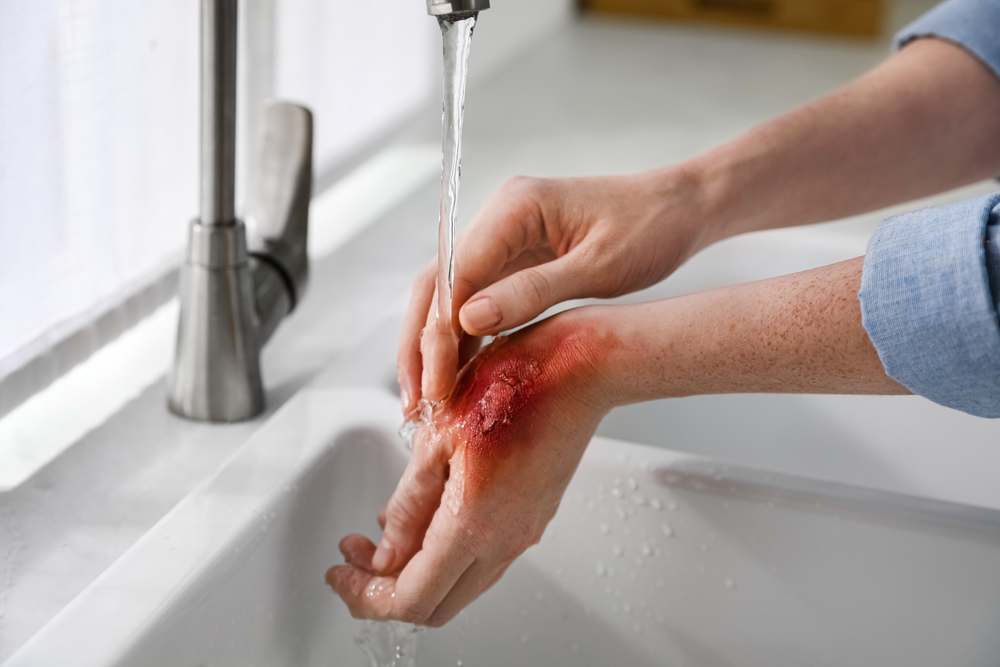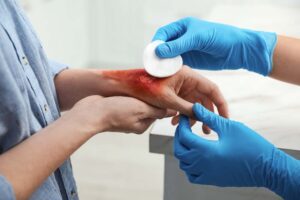 Despite being a rare occurrence during car accidents, fires can happen and open flames are the easiest way to suffer a burn injury. The moments following a car accident are often disorienting. If a fire is involved in a car accident, this adds uncertainty to the scene. Any car accident injury can be severe, but car accident burn injuries tend to be unstable and should be evaluated as soon as possible.
Despite being a rare occurrence during car accidents, fires can happen and open flames are the easiest way to suffer a burn injury. The moments following a car accident are often disorienting. If a fire is involved in a car accident, this adds uncertainty to the scene. Any car accident injury can be severe, but car accident burn injuries tend to be unstable and should be evaluated as soon as possible.
AICA Orthopedics at Snellville knows that the circumstances surrounding car accidents are uncertain and often difficult to navigate, especially if you have sustained any injury during the wreck. We see car accident injuries daily, and our state-of-the-art team is here to help you from the initial injury through your healing process.
What Is a Burn Injury?
Burns are painful wounds that leave the body open to infection and even death. You may not think car accidents can result in burns, but they are a definite possibility, especially when an open flame is involved. Burns can also be a result of chemicals and electricity.
Anatomy of the Skin
Your skin is the largest organ of the body. It covers the entire body and serves as a protective shield against infection, injury, heat, and light. It helps regulate your body temperature, is responsible for sensory input, and has many other important functions.
The skin is made up of three distinct layers: the epidermis, the dermis, and the subcutaneous fat.
Epidermis
This is the thin outer layer of your skin. It is the layer that gives the skin its color.
Dermis
The dermis is the thickest layer of skin. It contains blood vessels, lymph vessels, and nerves. It is also the location of hair follicles, sweat glands, collagen, and sebaceous glands. The dermis is held together by collagen which gives the skin flexibility and strength. The nerves in the dermis contain pain and touch receptors. If your dermis is damaged by burns this is considered a severe burn as the damage affects many important components.
Subcutaneous Fat
The deepest layer of skin and also called the hypodermis, the subcutaneous fat layer, contains collagen and fat cells. Their primary function is to conserve body heat and act as a shock absorber.
How Severe Are Burn Injuries?
The American Burn Association states over 480,000 burn or fire injuries are treated in the emergency room yearly, with the leading cause being an open flame. While the majority of burns have a high survival rate, burns can do such severe damage to the skin, your protective barrier to infection, that some burn injuries do end in fatalities. Burns are categorized by level of severity.
First-Degree Burns
Also called superficial burns, first-degree burns are the least severe and only affect the outer layer of skin or the epidermis. First-degree burns are typically painful, red, and dry but have no blisters. Sunburn is usually only a first-degree burn. You don’t usually see long-term tissue damage, but you may experience short-term changes in the color of the skin.
First-degree burns usually take only a few days to heal.
Second-Degree Burns
Second-degree burns are also called partial thickness burns. They involved the epidermis as well as part of the dermis. The burn site will usually swell and be blistered and red. The associated pain is higher than with a first-degree burn.
Due to their severity, second-degree burns sustained by an accident victim can take several weeks to heal.
Third-Degree Burns
Third-degree burns destroy the affected epidermis and dermis and potentially go into the subcutaneous tissue, the deepest layer of skin. These burns are also called full-thickness burns and look blackened or even white. These burns destroy hair follicles, sweat glands, and even nerves. Due to the nerve damage, you most likely will not feel pain on the burn itself, but the surrounding area will be painful.
Third-degree burn victims will often require surgery to repair the damaged areas as well as undergo physical therapy and continued medical care after the initial healing period, which can take weeks to months.
Fourth-Degree Burns
This is the most severe type of burn. This burn goes through all layers of skin, destroying hair follicles, sweat glands, and nerves. It goes so deep to involve muscle and bone damage potentially made. There is no feeling in the immediate area of the burn, but the surrounding areas will be extremely painful.
Fourth-degree burns are the most dangerous and are often fatal. Once the initial healing is over, sufferers of fourth-degree burns undergo months of rehabilitation and continued medical treatments.
What Causes a Burn?
While the primary cause of burns is an open flame, there are other ways to sustain burns. You can suffer burns from chemicals, electricity, or electromagnetic injury. Open flames are the most common way to sustain burns in a car wreck; however, chemical burns are also common due to the different chemicals required for a car to run.
What Is the Best Way to Treat Burns?
 The key to successful burn treatment is seeking treatment immediately. First-degree burns can typically be managed at home with basic first aid. One of the main tenets of burn treatment is keeping it clean and covered, hydration, and monitoring for infection and other long-term issues.
The key to successful burn treatment is seeking treatment immediately. First-degree burns can typically be managed at home with basic first aid. One of the main tenets of burn treatment is keeping it clean and covered, hydration, and monitoring for infection and other long-term issues.
Because your skin is part of the body’s thermoregulation, burn victims will often feel cold. As the body cools down from the high temperatures you were exposed to, the body may try to cool too fast. Keeping your internal temperatures up is very important.
Dehydration can be counteracted by IV fluids and blood loss via blood transfusions. Because of how painful burns and the healing process can be, patients may need to be sedated or given anti-anxiety medications.
Treating First-Degree Burns
Remove any clothing or jewelry near the burn and run cool, not cold, water over it. Pain and discomfort from sunburns can be alleviated with aloe vera gel and over-the-counter pain medication.
Treating Second-Degree Burns
You should have second-degree burns evaluated by a doctor. The treatment is similar to first-degree burns, but your doctor can prescribe a stronger antibiotic cream, usually a silver-based cream, to kill bacteria.
Treating Third-Degree Burns
The only burns more severe than third-degree are fourth-degree burns. Third-degree burns are life-threatening and require immediate treatment and very careful monitoring. Third-degree burns will almost always require skin grafts. Skin grafts are used to replace damaged tissue with healthy skin. Sometimes grafts will need revisions and are susceptible to contractures as the skin heals.
Diagnosing Burns
There are no special tests to diagnose a burn. Your doctor will often run blood tests to assess the general state of your hydration and blood volume, as well as monitor for infections. You may have x-rays or other state-of-the-art imaging done to diagnose other injuries sustained in a car accident.
Minor burns
- First and second-degree burns
- Affect less than 10% of the body
- Don’t require hospitalization
Moderate burns
- Second-degree burns
- Affect 10% of the body
- Burns of the hands, feet, and genitals are often considered moderate regardless of the degree of burn
- Will sometimes require hospitalization
Severe burns
- Third and fourth-degree burns
- Only require 1% coverage of the body
- Require hospitalization
What Should You Expect During Burn Recovery?
Complications of burns are often more dangerous than the burns themselves because when you suffer a burn, you are damaging the protective layer around your body. The skin keeps out bacteria and protects your internal organs from injury and burns damage that leaves you more susceptible to infection.
All serious injuries come with the risk of going into shock, and burns are no exception. Symptoms of shock include clammy skin, rapid heart rate, shallow breathing, and even unconsciousness. The best way to treat shock, besides treating the injuries, is to elevate the person’s legs, keep them warm, and call for emergency services.
Infection is probably the most dangerous aspect of burn injuries. The skin is the primary defense your body has against bacteria and germs. Even a mild infection is at a high risk of turning to sepsis and death. In order to prevent infection, keep the burn covered, take any antibiotics prescribed to you, and monitor the burns constantly for any changes in the burn.
Other complications include:
- Dehydration
- Scars and Contractures
- Edema
- Pneumonia
- Low blood pressure
Contact AICA
If you have been in a car accident, AICA Orthopedics is ready to perform state-of-the-art diagnostics to determine the extent of your injuries. If you have suffered burns in your car wreck, following diagnosis and treatment, our orthopedic doctors can collaborate with your burn specialists to develop a treatment plan throughout your recovery. Physical therapy can improve strength and flexibility, and a visit with a chiropractor can help alleviate pain while you heal.
AICA Orthopedics at Snellville handles auto accident injuries daily, and we can answer any questions you may have from start to finish. We are also able to perform any necessary orthopedic or spine surgery your injuries may require as a result of non-burn injuries. Early medical attention leads to faster healing times; call or visit us online to get started at AICA Orthopedic Snellville or another of our locations near you.
